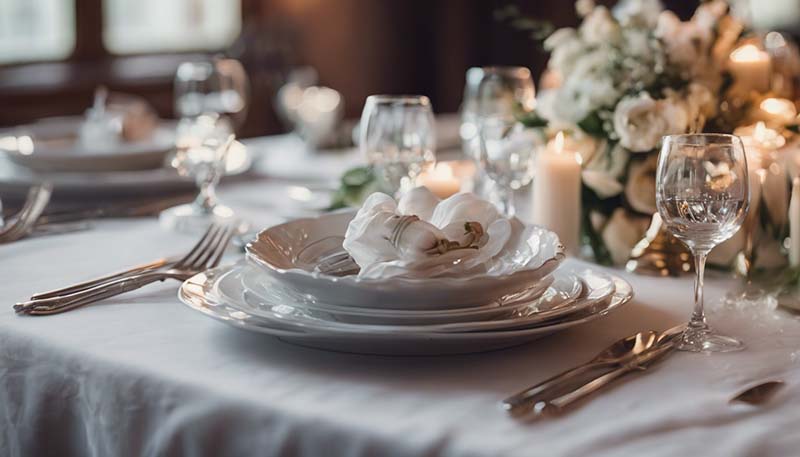The Art of Table Setting: Tips for Every Occasion
The Art of Table Setting: Tips for Every Occasion
Table setting is an art form that can elevate the dining experience, whether it's a casual family dinner, a formal event, or a special celebration. The way you set the table can convey your style, create a welcoming atmosphere, and even influence the mood of your guests. In this article, we'll explore the basics of table setting and provide tips for different occasions.
Basic Table Setting Principles
Before diving into specific occasions, let's go over some fundamental principles of table setting:
- Place Setting Basics: Start with the basic place setting, which includes a dinner plate, salad or dessert plate (if applicable), and a charger (optional). The dinner fork goes to the left of the plate, and the dinner knife and spoon are placed to the right.
- Glass Placement: The water glass is placed above the knife, and the wine glass is placed to the right of the water glass. If you're serving multiple types of wine, the glasses should be arranged from the least to the most robust in flavor.
- Napkin Etiquette: The napkin can be placed on the plate, on the chair, or to the left of the forks. If using a napkin ring, fold the napkin to fit inside the ring and place it to the left of the forks.
- Flatware and Utensils: Any additional flatware, such as for seafood or dessert, should be placed above the dinner plate, with the most frequently used items closest to the plate.
- Centerpiece and Decor: Choose a centerpiece that complements the occasion and doesn't obstruct the view of guests. Decorative elements should be tasteful and not overly distracting.
Table Setting for Different Occasions
Now that we've covered the basics, let's explore how to adapt your table setting for various occasions:
Advertisement
Casual Family Dinner
For a casual family dinner, simplicity and comfort are key. Use everyday dinnerware and focus on creating a welcoming atmosphere:
- Use durable, easy-to-clean dinnerware that complements your tablecloth or placemats.
- Keep the table uncluttered with only the necessary flatware and a water glass for each guest.
- Add a small vase with fresh flowers or a simple centerpiece to bring warmth to the table.
Formal Dinner Party
When hosting a formal dinner, attention to detail and a touch of elegance are essential:
- Use fine china, crystal glassware, and high-quality linens to create a refined look.
- Place a charger under each dinner plate to add a layer of sophistication.
- Use multiple types of flatware and glassware, ensuring they are arranged in the correct order.
- Consider adding a formal centerpiece, such as a candelabra or a low, wide arrangement of flowers.
Special Celebrations
For birthdays, anniversaries, or holidays, you can add a personal touch and make the occasion feel extra special:
- Choose a color scheme or theme that reflects the celebration.
- Use personalized or commemorative dinnerware, if available.
- Decorate the table with festive elements, such as themed place cards, candles, or seasonal decor.
- Consider adding a dessert plate and flatware for a multi-course meal.
Outdoor Dining
When dining al fresco, consider the elements and the relaxed nature of the setting:
- Use lighter, more casual dinnerware that can withstand outdoor conditions.
- Opt for sturdy, weather-resistant linens or placemats.
- Choose a centerpiece that complements the natural surroundings, such as a collection of potted herbs or a simple vase with wildflowers.
- Ensure that flatware and glassware are secure and won't easily tip over with a light breeze.
Final Tips and Considerations
Here are a few final tips to keep in mind when setting your table:

- Plan Ahead: Consider the flow of the meal and the courses being served when arranging your table. This will help you determine what flatware and glassware are necessary.
- Practice Etiquette: Familiarize yourself with basic table etiquette to ensure that your guests feel comfortable and know how to use the various items at their place setting.
- Be Creative: While it's important to follow general guidelines, don't be afraid to add your personal touch to the table setting. This is your opportunity to express your style and make the dining experience memorable.
- Test Run: Before your guests arrive, do a test run of your table setting. This will help you identify any issues or omissions and ensure that everything is in its proper place.
With these tips in mind, you're ready to set a table that not only looks beautiful but also enhances the overall dining experience. Whether it's a casual family meal or a formal affair, the art of table setting can transform the atmosphere and make any occasion feel special.